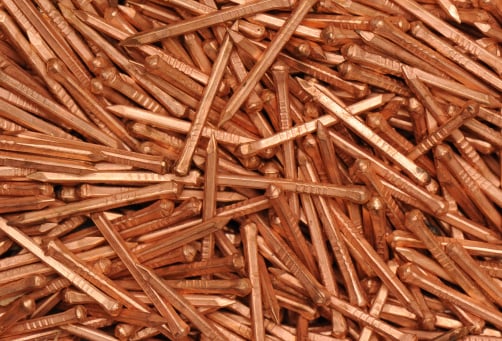Can Copper Nails Kill Tree Stumps? Here’s How to Do It
Nail your stump-killing project with this simple trick


- Hammer
- Drill
- Pure copper nails (at least 3 inches long)
If you’re looking for an inexpensive way to deal with an annoying tree stump, you’re likely wondering, “Can copper nails kill tree stumps?” While it can take months and likely won’t be effective on large stumps, using copper nails to kill a small-to-medium-sized tree stump is safer and easier than other methods, plus it’s budget-friendly. Here’s how to use copper nails to kill a tree stump.

Choose the Right Copper Nails
Not all copper nails will effectively kill a tree stump. Make sure you purchase solid copper nails, as copper-clad or coated nails won’t have the same effect. The oxidation of pure copper is what inhibits the stump’s ability to regrow, so this step is crucial for success.
Drill Pilot Holes in the Stump
Using a drill with a ¼-inch bit (or anything smaller than the diameter of the nails you’re using), drill pilot holes in the stump to make it easier to insert the nails. These should be at a slight downward angle and roughly ⅔ of the length of your copper nails. Space the holes evenly, about ½-inch apart, around the top and sides of the stump.
Hammer the Copper Nails into the Pilot Holes
Next, firmly hammer the copper nails into the drilled holes. Ensure they are driven completely into the stump to get the full effect.
Monitor the Stump’s Decay Process
Over time, the copper will disrupt the stump’s nutrient absorption, slowly causing it to rot. This process can take one to three months, or possibly a year or more, so be patient and wait before trying alternative methods. Check the stump every week or so for signs of decay.
Remove the Stump Remnants
Once the stump becomes soft and brittle, you can don thick safety gloves and break it apart or use a shovel to remove the remaining tree debris. If necessary, you can add more copper nails to stubborn areas that are still showing signs of life.
Mistakes to Avoid When Using Copper Nails
When hammering copper nails into a tree stump, be sure to avoid these common pitfalls:
Using the wrong nails: The nails must be pure copper; copper-clad or coated nails won’t work.
Not using enough nails: A few nails won’t deliver enough copper to kill a stump, so be sure to space them throughout the stump.
Using nails that are too short: When it comes to selecting your pure copper nails, the longer the better, and they should be at least three inches long.
Skipping the pilot holes: Drilling pilot holes ensures that the nails penetrate deep enough to disrupt the stump’s ability to regenerate.
Expecting a quick fix: Unlike many other ways to kill a tree stump, using copper nails takes a long time to be effective, taking between a month to a year or possibly more, depending on the size and type of tree.
Attempting to kill a large tree stump with copper nails: This method works best for small to medium-sized stumps (up to 14 inches in diameter); large stumps can take years or may not die at all.
When to Kill a Tree Stump
You can use copper nails to kill tree stumps at any time of the year. However, the decomposition process is much slower during colder months due to reduced microbial activity in the wood. For the best results, start in spring or early summer when warmer temperatures and higher moisture levels will help accelerate the process.
DIY vs. Hiring a Pro
Using copper nails to kill a tree stump is DIY-friendly, but it’s a very long process. If you want the stump gone ASAP, stump grinding is the best method, albeit far less safe and simple for a DIY-er. The average cost to rent a stump grinder is around $300, though your budget can range anywhere between $90 and $400, depending on the size and brand of the grinder, as well as where you rent it from and the rental time length. You should also budget $20 to $50 for the protective gloves and safety glasses.
Considering the average cost to grind a stump professionally is $250, hiring a local stump removal professional has a very comparable budget if you need to remove one or two small stumps. However, projects can cost as high as $1,600 for large or multiple tree stumps, so you’ll want to get a custom quote from at least three professionals to budget correctly. It bears repeating that copper nails won’t effectively kill a larger stump, so if that’s what you’re looking for, it’s best to explore stump grinding or other more potent methods of stump removal.
Frequently Asked Questions
If you’re wondering who will pick up stump grindings or the remnants of your stump once it’s fully decayed, consider hiring a professional landscaping service. You can also hire a professional stump grinding service if you have a stubborn stump that you can’t remove on your own. If you choose that route, be sure to include the removal of leftover debris in your contract.
If you’re wondering whether you can plant a tree where the stump was removed, know that the soil conditions won’t be ideal, so you should avoid it. The soil beneath the previous tree will likely be depleted of nutrients, plus there may be roots left behind that will seriously hinder the growth of a new tree. Also, if you use salt or other chemical solutions to kill the stump, these can linger in the soil for months or even years and prevent healthy growth. It’s best to choose a different spot that’s at least three feet away for a new tree, or wait at least a year and thoroughly amend the soil before you plant.
If you’re looking to rot a tree stump fast, potassium nitrate will work far quicker than copper nails. First, drill several holes into the stump using a power drill, then pour potassium nitrate pellets into the holes. Next, add water to help the chemical absorb into the wood, thoroughly soaking the stump to ensure the pellets dissolve and spread evenly. Afterward, cover the stump with a tarp to retain moisture and block sunlight, then place mulch on top to secure it in place.















